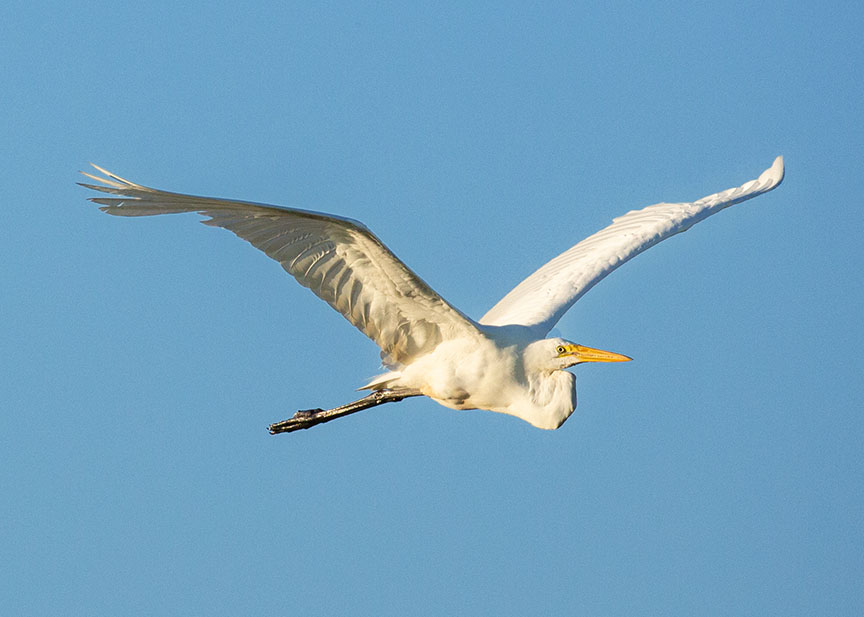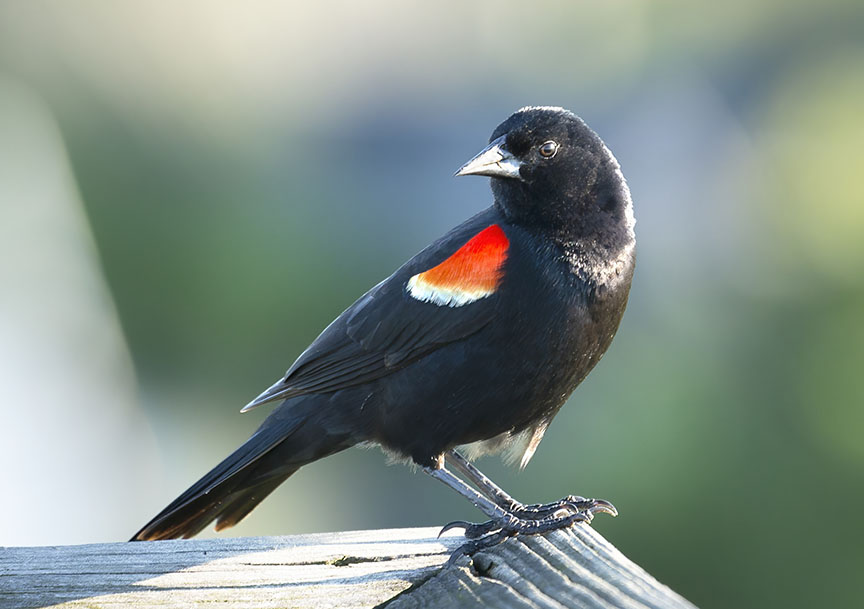How to Succeed at Cape May Bird Photography
WRITTEN BY: BRUCE LOVELACE
UPDATED ON: July 30, 2024
 Flock of Cape May seagulls in flight
Flock of Cape May seagulls in flightCape May is a bird photographer's paradise. It's a world-renowned destination for bird geeks. It's a special place with a diverse habitat, and a huge migratory bird presence.
Combine the tips in this post for capturing stunning bird photos with a few camera equipment recommendations and you'll succeed with your Cape May bird photography.
Time of the day and year , shooting the best locations, lens selection, and your camera settings all affect how successful you will be at photographing the multitude of birds that visit or live in Cape May.
PhotographY Of Birds in flight
You're likely wondering how hard it is to photograph birds in flight. It's one of the most challenging genres of nature photography that you can try. As you can see in my photo below that despite a super fast shutter speed, I still did not get a sharp photo of this pair of seagulls flying over the beach in North Cape May.
There are several potential reasons why your photos will not be sharp in situations like this. They include missed focus, blur from subject or camera movement, and using a high ISO settings
HIGH ISO. Depending on how high you set it, higher ISO settings can degrade your image with a lack of fine detail and the appearance of digital noise. Cameras have different performance when it comes to using high ISO setting. My older Canon 5D Mark III DSLR, (2012 release date), does not do as well as my new Canon R6 M II (2022 release date)
FOCUS. Birds that are stationary are much easier to photograph than birds in flight. When birds fly, the distance from your camera to the bird is changing rapidly and you need a camera that focus tracks the birds at they fly.
SHUTTER SPEED. Fast moving targets need a super short exposure time to "freeze" the action. Blur from too slow of a shutter speed is the single biggest issue that confronts bird photographers.
 2 seagulls in flight, North Cape May
2 seagulls in flight, North Cape MayCamera settings: 1/2000 second at f/5.6, ISO of 2000
Even after using very powerful software Topaz Lab Sharpen AI, I was unable to achieve the level of sharpness I wanted.
Contrast the photography of birds in flight with the photography of birds at rest and you'll see there is a big difference in how you approach them.
The photo above of the Red-winged Blackbird was taken at the South Cape May Meadows Preserve on Sunset Blvd. The image is tack sharp with a much slower shutter speed of 1/400 second.
Recommended Camera Settings For Bird Photography
Camera settings will vary significantly between birds in flight and stationary birds. You'll encounter both kinds of birds when you photograph birds in Cape May. Additionally, you may have to adjust from these starting recommendations, depending on the type of bird, and the lighting conditions. We start by recommending the settings that will be good for both types of bird photography.
ISO. Set the ISO as low as you can, based on the lighting conditions and the shutter speed that you need for blur-free images. An ISO of 400 is a good starting point, as most cameras maintain solid image quality at this level.
AUTO-FOCUS. The better and faster the auto-focus system your camera uses then the better success rate you'll have. Settings that limit the focus area to the center of your frame work best and "tracking" focus modes are the best one to use for moving targets like birds.
Basic Settings For Birds in Flight
SHUTTER SPEED. The recommended starting point for setting your shutter speed for birds in flight is 1/2000 second. With larger slower birds, like the Blue Heron and the Great Egret that flies slowly with just two wingbeats per second, you can shoot at slower speeds like 1/1600 and sometimes even 1/800 second, depending on the direction and distance that the birds are flying from you.
Faster, smaller-winged birds like humming birds and predator birds like falcons and hawks may require a shutter speed even quicker than 1/2000 second, such as 1/2500 or 1/3200 second.
APERTURE. Achieving perfect focus with birds in flight is very challenging, even with the sophisticated focus tracking that more recent and "pro" cameras have. To improve your chances of getting perfectly focused photos use an f/stop of f/6.3 or f/8.0
NOTE: The above settings may mean you'll need a higher ISO setting, particularly if you're not shooting in bright sunlight.
BASIC Settings For Stationary Birds
SHUTTER SPEED. Start with 1/400 second as a shutter speed for stationary bird photos. That will prevent motion blur, even if you're using a long telephoto lens. When your subject is perfectly still AND you have a steady hand, you can use slower shutter speeds. For birds that may be walking or hopping about, or birds that are feeding, I recommend you speed up your shutter speed to 1/800 second or faster.
APERTURE. Shoot wide open with the smallest f/stop number your lens will give you. This will enable your camera to use faster shutter speeds and lower ISO settings. An additional benefit of using large apertures is that the background behind your subject will render soft and less distracting.
"Fast" lens have maximum apertures of f/2.0 or f/2.8. More affordable typical hobbyist and beginner lenses have maximum apertures of f/4.0 or f/5.6.
 Early Morning Flight of The Great Egret
Early Morning Flight of The Great EgretCanon 5D Mark III with EF 100-400mm lens
Exposure was 1/4000 second at f/8, ISO=1600
Tips for Bird Photography in Cape May
- Try to do your bird photography in the early morning or late afternoon, when the birds are most active.
- Be patient and stay quiet. Try to stay still in one spot for an extended period of time. Birds are easily frightened, so take your time and go slowly when you do have to move.
- Use powerful binoculars to get a closer look at the birds that are at great distances.
- Bring a camera with a long lens to magnify them as much as possible.
- Use a field guide to birds. That will help you identify the species that you encounter and photograph.
FAQ
Click on any question below about bird photography and your answer will be revealed.
Why is Cape May so good for birding and bird photography?
Why is Cape May so good for birding and bird photography?
The biggest reason why Cape May is so good for birding and photography is its unique geography. The Cape May County peninsula is a narrow strip of land that sticks out into the Atlantic Ocean. This makes it a natural bottleneck for migrating birds. Many species of birds are funneled down the peninsula as they travel north in the spring and travel south in the fall.
The topography of Cape May includes forests, fields, wetlands, and beaches. This diversity of habitats attracts a wide variety of bird species and gives photographers an abundance of possibilities for photographing birds out in the open areas.
What month is best bird photography in Cape May?
What month is best bird photography in Cape May?
The best time of the year for photographing birds in Cape May is September through November when so many species visit during their migration. Late September is the peak season and the weather is very pleasant for shooting photos outdoors.
Where is the best place to photograph birds in Cape May?
Where is the best place to photograph birds in Cape May?
To have the most chances for photographing birds, simply avoid the crowds. Visit the protected natural areas, such as the national Wildlife Refuge, the Observatory, the Edwin B. Forsythe National Wildlife Refuge, and Higbee Beach Wildlife Management Area. These areas provide safe havens for birds and many opportunities to photograph them.
What lens is best for photographing birds in Cape May?
What lens is best for photographing birds in Cape May?
The best lens for photographing birds is a telephoto lens of at least 400mm. Prime telephoto lenses produce the best image quality and zoom telephoto lenses are the most versatile because you can easily switch between closer and distance shots.
I hope this post has inspired you to enjoy and will help you take better bird photos in Cape May.
National Geographic lists Cape May, New Jersey as a World's Best destination for birding. With today's remarkably sophisticated cameras and advanced lens designs, it's a great time to travel to Cape May and photograph the many species of birds.

Bruce Lovelace is the publisher of TravelingPhotographer.com. Bruce shot portraits full time for over 35 years. Now he shoots more travel photography. Read more about him on the About Page. He also publishes how to articles and camera gear reviews at the Photography Tips and Canon Geek websites.
The Traveling Photographer Location on Google My Business







